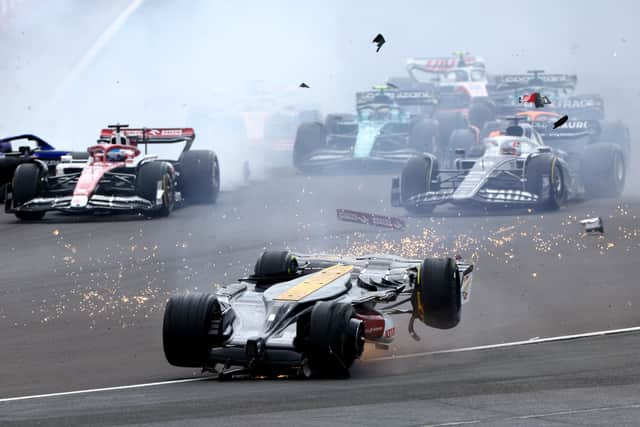Halo in F1: what is car device, Zhou Guanyu Silverstone crash explained, who invented it, what is it made of?
and live on Freeview channel 276
Formula 1 returned to England over the weekend as Sliverstone hosted an action packed contest.
The eventual winner Carlos Sainz fought his way past Ferrari team-mate Charles Leclerc in a brilliant 10-lap shootout to the chequered flag, following a safety car period to claim his first ever Formula One victory.
Advertisement
Hide AdAdvertisement
Hide AdSergio Perez finished second in the race , with Lewis Hamilton finishing third after he was able to overtake Leclerc with four laps of the 52 remaining.
Despite an exhilarating day of racing, Sainz’ victory was largely overshadowed by two harrowing crashes at the British Grand Prix. Both drivers avoided serious injury due to the intervention of a halo device which was modified onto their vehicles.
What happened at the British Grand Prix?
At the start of the F1 showpiece, Guanya Zhou’s Alfa Romeo was flipped upside down at 160mph at the first bend before skidding across the gravel and over the tyre barrier.
Zhou was eventually removed safely and taken to the medical centre for examination, where he has since been declared fit.
Advertisement
Hide AdAdvertisement
Hide AdEarlier in the F2 support race there was another crash which saw Dennis Haugers car land on top of Roy Nissany’s car as the two collided at high speed.
Miraculously both drivers emerged uninjured from the crash and this has largely been credited to the halo protection device.
Roy Nissany has since posted on Twitter: “Thank you all so much for the concern. I’m ok , it’s part of racing and luckily the halo was there for me.”
He is the latest in a series of drivers to be saved by the halo device but what is it and how does it work?


What is the halo?
Advertisement
Hide AdAdvertisement
Hide AdThe halo is a wishbone-shaped titanium bar covered with carbon fibre, which sits on the top of the cockpit of the car and wraps around the driver’s head.
The FIA (Formula One governing body) claims the halo is strong enough to “support the weight of two African elephants and sturdy enough to deflect a large, full suitcase at a speed of 225kph(140mph)”.
When and why was the halo introduced?
The halo was first trialled in F1 in 2016 before it became mandatory across all channels of the sport two years later in 2018.
F1 has always been a dangerous sport but over recent years safety has been taken more seriously following the deaths of Henry Surtees in a F2 race in 2009, Jules Bianchi at the 2014 F1 Grand Prix and Justin Wilson at an IndyCar event in 2015.
Advertisement
Hide AdAdvertisement
Hide AdWhile crash helmets had previously been very effective in preventing head injuries,these incidents highlighted that more needed to be done to protect drivers’ heads from flying debris or the car flipping.
What was the initial reaction to halo?
When the halo was first introduced to F1, it was initially met with some resistance from drivers who disliked the look of the protective ring around what had previously been a completely open cockpit.
Many high profile drivers in the sport weren’t happy with the aesthetics of it. In 2016, Lewis Hamilton described it as the “worst looking modification” in the sport’s history.
The other argument from some drivers was that it would affect their visibility, looking out of the cockpit.
Who has been saved by the halo?
Advertisement
Hide AdAdvertisement
Hide AdThe halo device has received a great deal of praise following the events at Silverstone but it’s not the only time that the device has been credited with saving lives.
Charles Leclerc walked away from a first corner collision at the 2018 Belgian Grand Prix which saw Fernando Alonso’s McLaren land on his Sauber.
The halo was also lauded for protecting Romain Grosjean in his fireball crash at the BahrainGrand Prix in 2020, while Lewis Hamiliton avoided injury following a clash with Max Verstappen’s at the Italian Grand Prix in 2021. Speaking afterwards, Hamilton, who was initially critical of the device said: “Thank God for the halo which saved me, and saved my neck.”
Comment Guidelines
National World encourages reader discussion on our stories. User feedback, insights and back-and-forth exchanges add a rich layer of context to reporting. Please review our Community Guidelines before commenting.
